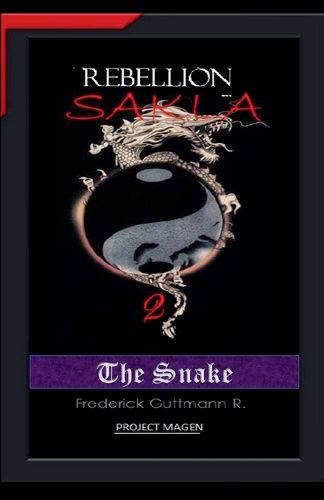Readings Newsletter
Become a Readings Member to make your shopping experience even easier.
Sign in or sign up for free!
You’re not far away from qualifying for FREE standard shipping within Australia
You’ve qualified for FREE standard shipping within Australia
The cart is loading…






This title is printed to order. This book may have been self-published. If so, we cannot guarantee the quality of the content. In the main most books will have gone through the editing process however some may not. We therefore suggest that you be aware of this before ordering this book. If in doubt check either the author or publisher’s details as we are unable to accept any returns unless they are faulty. Please contact us if you have any questions.
This second part of The Sakla Rebellion is an explanatory thesis on the identity of the deity Jehovah and other gods who accompanied him. The names (in Hebrew "shem" or identity, destiny) of the Hebrew deity denoted epithets, both for one or more entities (beings, consciousnesses) that appear referred to in Hebrew texts. This treatise begins, then, by unraveling issues relating to the identity of the god known as Jehovah (or IHVH). The next part exposes the origin of the human race with the use of comparative mythology and paleontological and archaeological records. The next section continues by delving into the records about various civilizations that existed before the history they tell in schools. The Lemurians (from Mu), the Atlanteans (from Poseidonis), Hyperborea and peoples whose memory only remains in legends and myths, and even evidence of populations that inhabited the Earth millions of years ago (even before the existence of the dinosaurs). ). The fourth part of the book deals with the entire theme of the story of the "fall" of man, from different perspectives, taking in Hebrew, Greek, Celtic, Scandinavian, Egyptian and Canaanite cultures. The dynamic of the Garden of Eden story is followed by the thesis about Satan. This part addresses the independent stories of folkloric figures from different peoples of the globe that coincide in the same context as an antagonistic figure of man, be it Loki for the Nordics, Cernunos for the Celts, Guayota for the Guanche indigenous people, Zu for the Sumerians, Iblis for the Arabs, Satan for the Hebrews, the devil for the Christians, Set for the Egyptians, Mot for the Hittites, Hades for the Greeks, Pluto for the Romans, Ahriman for the Persians or Pazuzu for the Babylonians, for example. This thesis structures the conception of religious concepts based on names such as Lucifer (or Luzbel), Beelzebub (or Baal-Zebub), Satan (or ha.Satan), the ancient serpent, Leviathan, the 7-headed dragon, the fallen cherub, the king of Tire or the prince of the power of the air. They are the same? Why several qualifiers for who could be the same "person"?
$9.00 standard shipping within Australia
FREE standard shipping within Australia for orders over $100.00
Express & International shipping calculated at checkout
This title is printed to order. This book may have been self-published. If so, we cannot guarantee the quality of the content. In the main most books will have gone through the editing process however some may not. We therefore suggest that you be aware of this before ordering this book. If in doubt check either the author or publisher’s details as we are unable to accept any returns unless they are faulty. Please contact us if you have any questions.
This second part of The Sakla Rebellion is an explanatory thesis on the identity of the deity Jehovah and other gods who accompanied him. The names (in Hebrew "shem" or identity, destiny) of the Hebrew deity denoted epithets, both for one or more entities (beings, consciousnesses) that appear referred to in Hebrew texts. This treatise begins, then, by unraveling issues relating to the identity of the god known as Jehovah (or IHVH). The next part exposes the origin of the human race with the use of comparative mythology and paleontological and archaeological records. The next section continues by delving into the records about various civilizations that existed before the history they tell in schools. The Lemurians (from Mu), the Atlanteans (from Poseidonis), Hyperborea and peoples whose memory only remains in legends and myths, and even evidence of populations that inhabited the Earth millions of years ago (even before the existence of the dinosaurs). ). The fourth part of the book deals with the entire theme of the story of the "fall" of man, from different perspectives, taking in Hebrew, Greek, Celtic, Scandinavian, Egyptian and Canaanite cultures. The dynamic of the Garden of Eden story is followed by the thesis about Satan. This part addresses the independent stories of folkloric figures from different peoples of the globe that coincide in the same context as an antagonistic figure of man, be it Loki for the Nordics, Cernunos for the Celts, Guayota for the Guanche indigenous people, Zu for the Sumerians, Iblis for the Arabs, Satan for the Hebrews, the devil for the Christians, Set for the Egyptians, Mot for the Hittites, Hades for the Greeks, Pluto for the Romans, Ahriman for the Persians or Pazuzu for the Babylonians, for example. This thesis structures the conception of religious concepts based on names such as Lucifer (or Luzbel), Beelzebub (or Baal-Zebub), Satan (or ha.Satan), the ancient serpent, Leviathan, the 7-headed dragon, the fallen cherub, the king of Tire or the prince of the power of the air. They are the same? Why several qualifiers for who could be the same "person"?